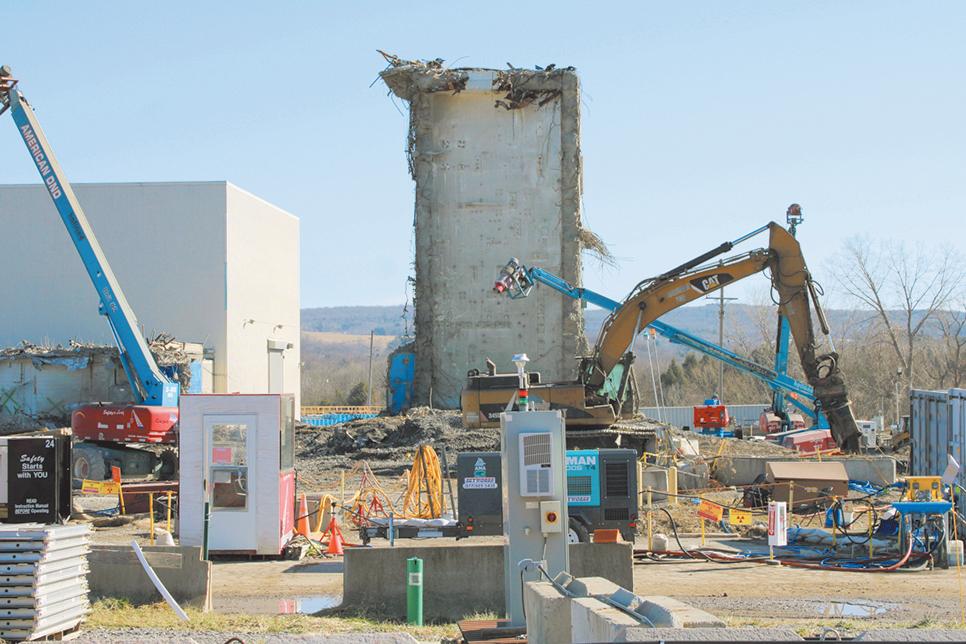Former Catt. Co. resident to finish seven continents marathon journey
South America, of which 10% is in Chile, 90% in Argentina,” he said. “This is one of the most pristine places on the planet, comprised of turquoise waters, beautiful glaciers, towering granite mountain horns and enhanced by the Andean deer, the guanacos, the reclusive pumas and the flights of the majestic condors.”
Most of this marathon will be run in the Torres del Paine National Park, a United Nations Educational, Scientific and Cultural Organization (UNESCO) site close to Santiago. Bruce said the course is on hardpacked gravel trails with views of glaciers and the Andes in the background, temperatures ranging 30–60 degrees Fahrenheit and often strong winds.
The Patagonia Running Festival is ranked No. 20 in the world’s 30 most challenging marathons, with a limited number of 300 runners. Regarding those top 30, Bruce said he has run No. 5 in Boston, No. 9 in Sydney, No. 14 in Africa, No. 22 in Niagara Falls, No. 27 in Athens and No. 29 in Antarctica.
much, noting it’s not an easy question to answer — “it’s complicated.” One aspect is based on the book, “Outlive: The Science and Art of Longevity” by Peter Attia, M.D., which he said indicates people want to live long, healthy, meaningful lives and modern medicine has increased our lifespans.
“But the quality of life often suffers as we age due to what is referred to as the ‘Four Horsemen’ — heart disease, cancer, diabetes and dementia,” Bruce said. “It appears that modern medicine focuses on late-stage treatment instead of early prevention.
Medicine’s blind spot!”
Besides working for Cornell University’s CCE for over 30 years, Bruce also served as a hospital administrator for a small rural hospital in Alabama as well as overseeing the hospice and home healthcare programs.
Originally from Moriah, N.Y., Bruce was the CCE director in Cattaraugus County for over 10 years, as well as the 4-H
Driving a car or truck is part of daily life for most people. Commutes to work or school, leisure trips or time spent behind the wheel as part of a profession compel people to drive each and every day. Although most trips to the office or the store are uneventful, the risk that something may go awry is present any time a person gets behind the wheel, and drivers need to plan accordingly.
The National Center for Statistics and Analysis says there were approximately 16,200 automotive accidents per day in the United States in 2022, the most recent year for data. This number has steadily risen over the last decade and may be attributable to a number of factors, including increased vehicle usage. Diamond and Diamond Lawyers in Canada says approximately four Canadians die and 175 are injured in impairment-related crashes every day. Though accidents occur every day, drivers can take steps to reduce their risk of being involved in one.
Stick to the speed limit
Speed limits are posted on roadways for a reason. Exceeding speed limits significantly increases the risk of getting into an accident, and many accidents are directly related to speeding. Slowing down can make roadways safer.
Eliminate distractions Smartphones, GPS devices, passengers, pets in the car, or anything that causes a person to take his or her eyes off of the road, even for mere
Program Leader for eight years. He left the area in 1985 to become director of the Institute of Food and Agricultural Science in Dade County, Fla. Bruce said he’s often asked why he runs so
For Bruce, this validated the need to be more proactive and focus on early prevention. While not everyone can or should run — especially marathons — he said this was his choice.
“As part of early prevention, I encourage
people to think about what they want to personally achieve, their contribution to their communities, the real health benefits — also consider your genetics/family history — and increasing one’s knowledge base of accessing services of professionals and information,” he said. Regarding marathons, only 1% of the U.S. population has run a marathon, but the popularity of this activity has surged starting in the 1970s. The U.S. Surgeon General in September 2024 indicated the uptick started spiking because of the loneliness epidemic via the COVID-19 pandemic, and the number of marathons has skyrocketed, according to the 50 State Marathon Club. Bruce is available to speak to interested groups on youth development, kindness volunteer programming, healthcare and marathoning as well as one of his other passions — the Kingdom of the Monarchs, based on his trip to Central Mexico, the overwintering home of the Monarch butterflies. He can be reached via email at dvbruce20@gmail.com.



seconds, can increase the risk of being in an auto accident. Accident Care and Treatment Center, Inc. says distracted driving is the primary cause of car accidents each year. Smartphones are a modern distraction, and keeping phones turned off and out of reach can keep drivers safer.
Change your perception
It is important to think of a car or truck as what it truly is: 3,000 pounds or more of fast-moving metal that can cause a lot of damage. Those who do not drive responsibly, or feel they are invincible behind the wheel, could be on a crash course for an auto accident. Treating a vehicle with respect is a must.
Leave a space cushion
Tailgating and aggressive driving maneuvers that do not leave an adequate distance between vehicles can compound the problem of accidents. Travelers insurance company urges drivers to stay at least three seconds behind the vehicle ahead of them, and longer for those driving heavier vehicles. The timing also should be extended when weather conditions are bad. A significant cushion enables drivers to stop safely or maneuver around to avoid an accident.
Improve visibility A cracked or dirty windshield or
Know your limitations
Geico notes the risk of a fatal crash is three times
at
than in the day for every mile driven. Although it may not be possible to avoid nighttime driving entirely, limiting it, particularly for those who have challenges seeing at night or in dim conditions, can help reduce accident risk. The same can be said for staying off of roads in inclement weather.
drive
Driving while under the
Photo provided
David Bruce, former Cornell Cooperative Extension director in Cattaraugus County, plans to run the Patagonia Running Festival in Santiago, Chile on May 3.
CCA launches initiative addressing food insecurity, Social Determinants of Health
SALAMANCA —
Did You Know?
The benefits of exercise for seniors are innumerable. In order to get the physical activity they need, many older adults are turning to pickleball. Pickleball combines elements of tennis, wiffle ball and ping-pong into an activity that is drawing new enthusiasts every day. Fans often say that pickleball is the most fun racket sport they have played. With a smaller court than tennis and a lighter ball, pickleball is ideal for seniors who
won’t have to worry about the sport being too highintensity. The Medical University of South Carolina says pickleball is the fastest-growing sport today, particularly among seniors. The 2023 Sports & Fitness Industry Association Report on Pickleball says pickleball has attracted 8.9 million U.S. players of all ages and fitness levels. The SFIA report notes that the 65+ age group accounts for the second highest number of participants.






Cattaraugus Community Action, Inc. announces the combination of four significant grant awards will be used to launch a comprehensive project aimed at addressing food insecurity and the needs outlined in the Social Determinants of Health Report. The combined funding, totaling $505,000, will support the Healthy Cattaraugus NY Partnership’s Social Determinants of Health Accelerator Plan. This includes $280,000 from the Highmark Blue Cross Blue Shield, $165,000 from the Buffalo Bills Foundation, $50,000 from the Western New York Foundation and $10,000 from the Cattaraugus Region Community Foundation. These funds will be used to alleviate and reduce food insecurity throughout Cattaraugus County by developing the following programs:
• Establishing mobile food pantries to serve food deserts throughout the county. These pantries will be colocated at clinics or centrally located areas, distributing both medically tailored food boxes and general food boxes to individuals in need.
• Implementing backpack programs at participating schools to ensure children living with food insecurity have access to nutritious food outside of school hours.
• Providing tailored food
boxes to those undergoing treatment for prevalent medical conditions within Cattaraugus County.
Food insecurity is a significant issue in Cattaraugus County. According to Feeding America, approximately 14.8% of the county’s population experiences chronic food insecurity. Additionally, according to the U.S. Census Bureau, more than 51% of families in Cattaraugus County live below the federal poverty line and are eligible for supplemental nutrition assistance programs. The problem is further compounded by food deserts due to many residents living more than 10 miles from the nearest supermarket.
“We are incredibly grateful for the generous support from these foundations,” said Mason Maynard, COO of Services at CCA. “This combined funding will enable us to make a significant impact on the health and wellbeing of our community.”
CCA will leverage its existing food pantry infrastructure and collaborate with key partners, including local schools and medical providers, the Seneca Nation, Nourish NY and FeedMore WNY, to ensure the success of this initiative
For more information about this project, contact Maynard at mmaynard@ccaction.org or call (716) 945-1041 ext. 131.
WVDP safely removes legacy cell, advancing Main Plant demo
WEST VALLEY —
Crews at the West Valley Demonstration Project have safely removed a concrete cell used during legacy nuclear fuel reprocessing operations as progress continues on the Main Plant Process Building demolition.
The Main Plant is one of the last remaining major facilities at West Valley, and the teardown is 88% complete. The U.S. Department of Energy
Office of Environmental Management (EM) says its successful demolition will further reduce environmental risks and position the site for the next phase in clean-up. The demolition began in September 2022 and is expected to be completed early this summer.
The Off-Gas Cell housed ventilation equipment for the Main Plant’s many tanks and vessels, as well as a
condenser for a low-level waste evaporator. The steel-reinforced concrete cell was 366 square feet in size with a ceiling height of 29 feet. Its walls varied in size from two feet to five feet thick.
During legacy fuel reprocessing operations, a leak of acid contaminated the cell’s northwest corner, requiring special demolition techniques to bring a portion of the cell wall to the ground.
“Safety comes down to planning, preparation and safe execution of work,” said Stephen Bousquet, Main Plant Project Director. “Our team worked together to carefully plan the controlled demolition of this cell while ensuring structural integrity and keeping contamination at its source.”
One special demolition technique involved crews painting lines from top to bottom on the outside of the cell to highlight the areas to be demolished. These lines guided the operator to remove small sections of the structure in a deliberate, controlled manner.
Workers deployed two pieces of equipment to safely and compliantly remove each cell section from top to bottom. An operator used a hydraulic hammer to chisel around a section and free it from the steel reinforcement.
Using a grapple, or claw, attachment, a second operator grabbed the section and lowered it to the ground for packaging. Crews ran misters during the work to control dust at its source.
“Interdisciplinary collaboration and lessons
Tips to renovate on a budget
learned from previous demolition activities has been an excellent combination for safety and success,” said Tom Dogal, facility disposition manager for CH2M HILL BWXT West Valley, EM’s cleanup contractor at the site. “This work evolution was executed without incident or unplanned radiological releases, and I am very proud of our team.”
Photo courtesy West Valley Demonstration Project
The Product Purification Cell, a highly contaminated cell resembling an elevator shaft, can now be seen clearly from this vantage point following the recent removal of the 366-square-foot Off-Gas Cell. Crews at the West Valley Demonstration Project removed the Off-Gas Cell in March.
































































































































